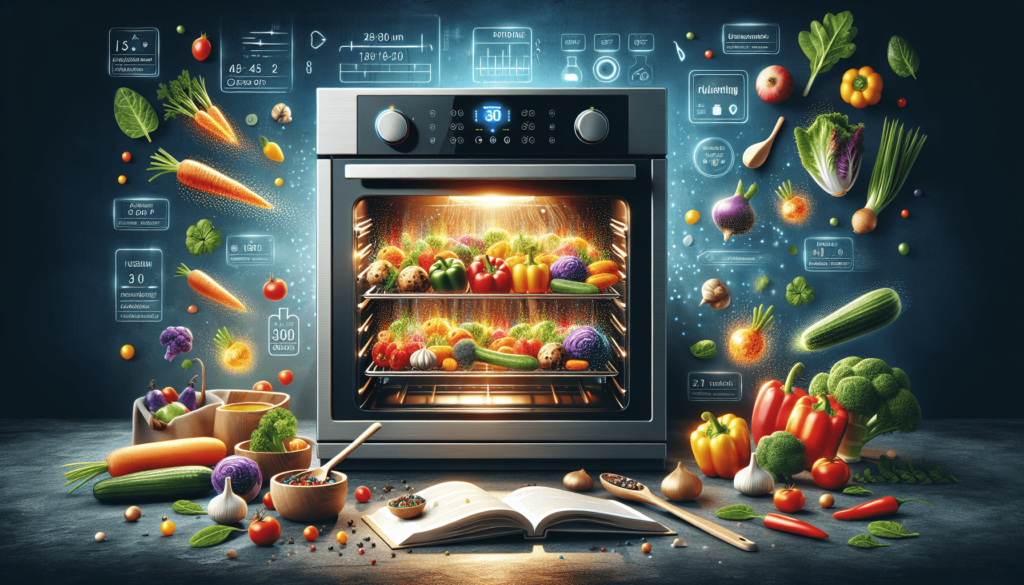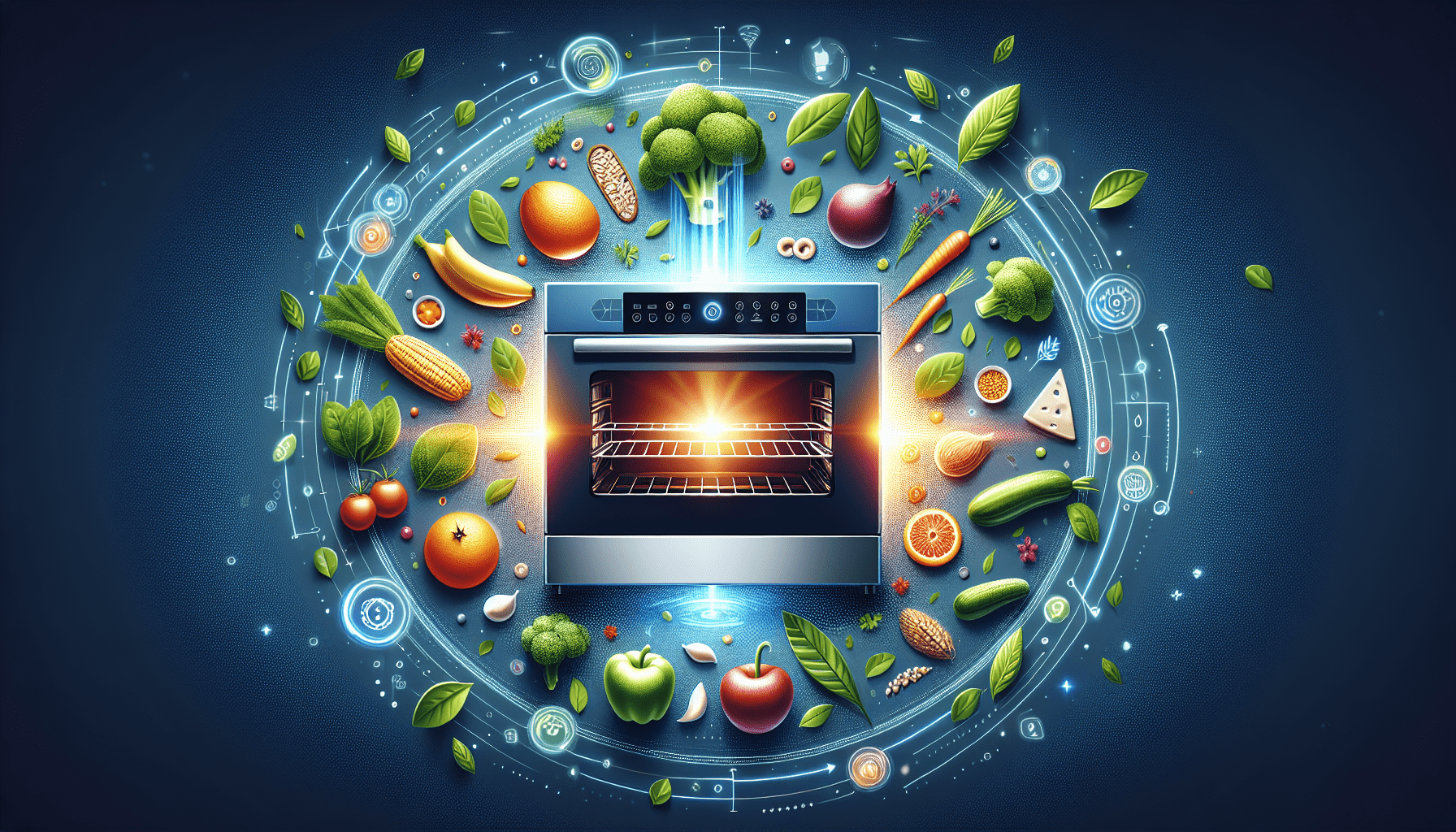In today’s fast-paced world, we are constantly looking for ways to make our lives more efficient and convenient. One area where this desire for convenience often clashes with our need for nutritious meals is in the kitchen. With the rise of smart ovens, cooking has become easier than ever, but are we sacrificing the nutritional value of our food in the process? In this article, we will explore how to maximize nutrient retention when cooking in your smart oven, so you can enjoy the convenience without compromising on your health.

Preparation Techniques
When it comes to maximizing nutrient retention in your meals, one of the most important steps is to start with fresh ingredients. Using fresh fruits, vegetables, and proteins ensures that you’re getting the highest levels of vitamins, minerals, and other beneficial nutrients. Look for locally sourced produce and organic options whenever possible.
In addition to using fresh ingredients, another preparation technique that can help retain nutrients is steaming rather than boiling. Boiling can cause water-soluble vitamins and minerals to leach out into the cooking water, reducing their nutritional value. Steaming, on the other hand, allows you to cook your food without direct contact with water, minimizing nutrient loss.
Preserving the peel and skin of fruits and vegetables is another way to retain nutrients. Many fruits and vegetables, such as apples, cucumbers, and potatoes, contain significant amounts of vitamins, fiber, and antioxidants in their skins. By leaving the peel intact, you can retain these valuable nutrients in your meals. Just make sure to wash them thoroughly to remove any dirt or pesticides.
For those who are short on time, pre-cut vegetables and fruits can be a convenient option. While cutting your own produce is ideal for maximizing freshness, pre-cut options can still provide a nutritious choice. Just be sure to check the expiration date and choose packages that show no signs of spoilage. Additionally, consider using pre-cut fruit and vegetable trays within a day or two of purchase to ensure the highest nutrient content.
Temperature and Time Considerations
When it comes to cooking, temperature and time play a crucial role in nutrient retention. It’s important to know the optimal cooking temperatures for different foods to avoid nutrient loss. For example, certain vitamins are heat-sensitive and can degrade at high temperatures. By cooking foods at lower temperatures when appropriate, you can help maintain their nutrient content.
Overcooking can also lead to nutrient loss, as prolonged exposure to heat can break down vitamins and other beneficial compounds. It’s important to monitor your cooking time and avoid overcooking your meals. This is where a smart oven with pre-set cooking programs can be particularly helpful. These programs are designed to automatically adjust temperature and cooking time for optimal nutrient retention.
In addition to avoiding overcooking, you can also reduce cooking time by using smaller cuts of meat or chopping vegetables into smaller pieces. By reducing the size of your ingredients, you can decrease the cooking time required, thus minimizing nutrient loss.
Proper Use of Cookware
The type of cookware you use can also have an impact on nutrient retention. It’s important to choose the right cookware that helps preserve the nutrients in your food.
When selecting cookware, opt for materials like stainless steel, cast iron, or ceramic. These materials distribute heat evenly and can withstand high temperatures without releasing harmful chemicals into your food. Avoid using aluminum or nonstick cookware, as they can leach chemicals into your meals and potentially compromise their nutritional value.
Covering pots and pans while cooking is another technique to retain nutrients. By covering your cookware, you trap steam and heat, which helps cook the food faster and more evenly. This also prevents moisture from evaporating, ensuring that the nutrients stay locked within the food.
Moisture Retention Techniques
Retaining moisture during the cooking process is essential for maintaining the nutrient content of your meals. There are several techniques you can use to achieve this.
Basting and marinating your meats can help keep them moist and flavorful. Basting involves brushing or pouring liquid, such as marinade or juices, over the meat while it cooks. This helps to prevent dryness and preserve moisture. Marinating meat prior to cooking can also have similar effects, as the meat absorbs the flavors and moisture from the marinade.
Using a lidded cooking dish can also help retain moisture in your meals. These dishes trap steam and prevent evaporation, resulting in juicy and flavorful dishes. Ceramic or glass baking dishes with tight-fitting lids are ideal for this purpose.
Adding liquid to your cooking can also help retain moisture. Whether it’s water, broth, or a flavorful sauce, adding liquid to your recipes can help prevent dryness and enhance the taste. Just be mindful of not adding too much liquid, as it can lead to excessive dilution of flavors.

Preserving Water-Soluble Nutrients
Water-soluble vitamins, such as vitamin C and B vitamins, are susceptible to degradation during the cooking process. However, there are techniques you can use to preserve these essential nutrients.
One method is to blanch vegetables before cooking them. Blanching involves briefly boiling the vegetables and then immediately transferring them to an ice bath to halt the cooking process. This technique helps retain water-soluble vitamins while still ensuring that the vegetables are cooked to your desired level of tenderness.
Cooking in minimal water can also help preserve water-soluble nutrients. Steaming or using a small amount of liquid during cooking can minimize nutrient loss. By cooking foods in their own juices or with just a splash of water, you can retain more vitamins and minerals.
Another way to preserve water-soluble nutrients is to use the cooking liquid for sauces. When you boil vegetables or proteins, valuable nutrients can leach out into the water. Instead of discarding this nutrient-rich liquid, you can use it as a base for sauces, gravies, or soups. This allows you to capture and utilize those important vitamins and minerals.
Importance of Properly Storing Ingredients
Properly storing your ingredients is not only crucial for food safety but also for maintaining their nutrient content. Here are some key considerations to keep in mind.
Maintaining the right storage temperature is essential for preserving the nutrient content of your ingredients. Most fresh produce should be stored in the refrigerator, while others may require different conditions. For example, some fruits like bananas and avocados should be stored at room temperature. Read the storage recommendations for each ingredient and adjust accordingly.
While it’s important to keep ingredients fresh, avoid keeping them stored for too long. Over time, fruits and vegetables can lose their nutrient content, especially if they are not properly stored. Keep an eye on expiration dates and aim to consume your ingredients within a reasonable timeframe to maximize their nutritional value.
When it comes to storing pre-cut ingredients, it’s important to do so properly to maintain their nutrient content. Place them in airtight containers or resealable bags and store them in the refrigerator. This helps prevent oxidation and moisture loss, preserving the nutrients for longer.
Smart Oven Features for Nutrient Retention
If you have a smart oven, you’re in luck! These ovens come equipped with features specifically designed to help maximize nutrient retention in your cooking.
Utilizing the steam cooking function is an excellent way to retain nutrients. Steam cooking involves using hot steam to cook your food, which helps to preserve vitamins, minerals, and natural flavors. This method also requires little to no added fats, making it a healthier cooking option.
Smart ovens often come with customizable pre-set programs that take the guesswork out of cooking times and temperatures. These programs are designed to ensure optimal nutrient retention, so make use of them whenever possible. Simply select the program that matches your dish, and the oven will automatically adjust the settings for you.
Smart sensors and automatic adjustments are other handy features found in some smart ovens. These sensors detect the moisture and temperature inside the oven and make automatic adjustments as needed. This helps maintain an ideal cooking environment and ensures that your meals retain their maximum nutrient content.
Selecting the Right Cooking Method
Choosing the right cooking method can greatly impact the nutrient retention of your meals. Let’s explore some of the best cooking techniques for preserving nutrients.
Grilling is a fantastic method that allows you to retain nutrients while adding a smoky flavor to your food. This cooking technique is particularly beneficial for lean proteins like chicken and fish. The high heat from the grill seals in the nutrients and juices, resulting in delicious and nutritious meals.
Stir-frying is another quick-cooking method that helps retain nutrients. By cooking your ingredients over high heat for a short amount of time, you can minimize nutrient loss. Stir-fried vegetables and proteins can retain their crisp texture and vibrant colors, as well as their nutritional value.
If you’re looking for precise temperature control and evenly cooked meals, sous vide is an excellent option. Sous vide involves vacuum-sealing ingredients in a bag and cooking them in a water bath at a precise temperature. This gentle cooking method ensures that the food retains its nutrients while achieving the desired level of doneness.
Incorporating Nutrient-Dense Ingredients
To further amplify the nutritional value of your meals, consider incorporating nutrient-dense ingredients. Here are a few suggestions:
Dark leafy greens, such as spinach, kale, and Swiss chard, are packed with vitamins, minerals, and antioxidants. Adding these greens to your dishes not only boosts their nutritional profile but also adds vibrant colors and delicious flavors.
Lean proteins, such as chicken breast, fish, tofu, or legumes, are excellent choices for maximizing nutrition. These protein sources are low in unhealthy fats and provide essential amino acids, vitamins, and minerals.
Choosing colorful fruits and vegetables is a simple way to ensure that you’re getting a wide range of nutrients. Opt for a variety of colors, such as berries, bell peppers, carrots, and sweet potatoes. The different pigments in these vibrant produce signify the presence of various vitamins and antioxidants.
Avoiding High-Fat Cooking Techniques
While some fats are beneficial for our health, it’s important to avoid cooking techniques that rely on excessive amounts of unhealthy fats. Here are some alternatives to consider:
Limit frying and deep-frying, as these methods involve submerging your food in hot oil. While these cooking techniques can add a crispy texture, they also increase the calorie and fat content of your meals. Instead, consider healthier alternatives such as baking, grilling, or sautéing with minimal oil.
When it comes to roasting, baking in the oven is a healthier option compared to high-heat roasting. Baking at lower temperatures for a longer duration can help retain more nutrients and flavors in your food.
Choose healthier cooking oils, such as olive oil, coconut oil, or avocado oil, when sautéing or dressing your meals. These oils contain unsaturated fats, which are beneficial for heart health. It’s important to use them in moderation, as even healthier oils still provide calories.
By following these tips and techniques, you can maximize nutrient retention and ensure that your meals are as nutritious as possible. Whether you’re using a smart oven or traditional cooking methods, paying attention to the quality of your ingredients, the cooking temperature, and the time can make a significant impact on the nutritional value of your meals. So go ahead and enjoy delicious and nutrient-rich dishes that nourish your body and support your overall well-being.
